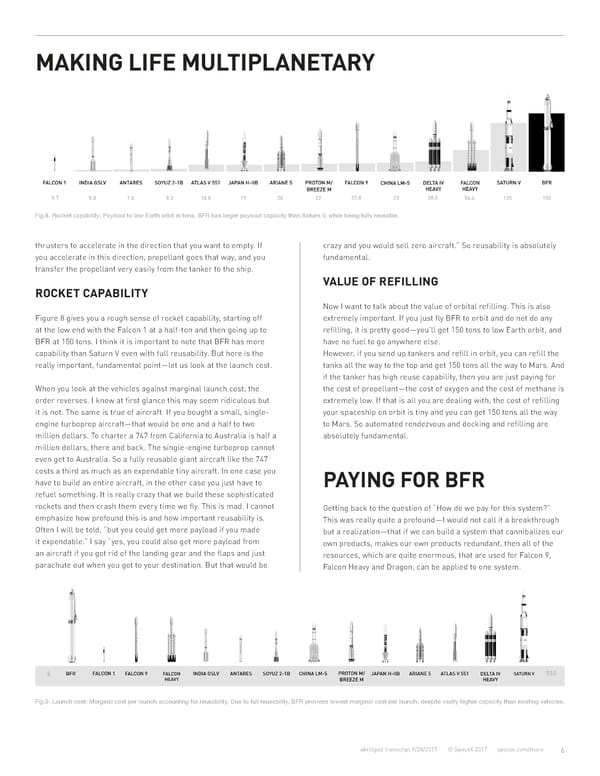MAKING LIFE MULTIPLANETARY Fig.8. Rocket capability: Payload to low Earth orbit in tons. BFR has larger payload capacity than Saturn V, while being fully reusable. thrusters to accelerate in the direction that you want to empty. If crazy and you would sell zero aircraft.” So reusability is absolutely you accelerate in this direction, propellant goes that way, and you fundamental. transfer the propellant very easily from the tanker to the ship. ROCKET CAPABILITY VALUE OF REFILLING Now I want to talk about the value of orbital refilling. This is also Figure 8 gives you a rough sense of rocket capability, starting off extremely important. If you just fly BFR to orbit and do not do any at the low end with the Falcon 1 at a half-ton and then going up to refilling, it is pretty good—you’ll get 150 tons to low Earth orbit, and BFR at 150 tons. I think it is important to note that BFR has more have no fuel to go anywhere else. capability than Saturn V even with full reusability. But here is the However, if you send up tankers and refill in orbit, you can refill the really important, fundamental point—let us look at the launch cost. tanks all the way to the top and get 150 tons all the way to Mars. And if the tanker has high reuse capability, then you are just paying for When you look at the vehicles against marginal launch cost, the the cost of propellant—the cost of oxygen and the cost of methane is order reverses. I know at first glance this may seem ridiculous but extremely low. If that is all you are dealing with, the cost of refilling it is not. The same is true of aircraft. If you bought a small, single- your spaceship on orbit is tiny and you can get 150 tons all the way engine turboprop aircraft—that would be one and a half to two to Mars. So automated rendezvous and docking and refilling are million dollars. To charter a 747 from California to Australia is half a absolutely fundamental. million dollars, there and back. The single-engine turboprop cannot even get to Australia. So a fully reusable giant aircraft like the 747 costs a third as much as an expendable tiny aircraft. In one case you have to build an entire aircraft, in the other case you just have to PAYING FOR BFR refuel something. It is really crazy that we build these sophisticated rockets and then crash them every time we fly. This is mad. I cannot Getting back to the question of “How do we pay for this system?” emphasize how profound this is and how important reusability is. This was really quite a profound—I would not call it a breakthrough Often I will be told, “but you could get more payload if you made but a realization—that if we can build a system that cannibalizes our it expendable.” I say “yes, you could also get more payload from own products, makes our own products redundant, then all of the an aircraft if you got rid of the landing gear and the flaps and just resources, which are quite enormous, that are used for Falcon 9, parachute out when you got to your destination. But that would be Falcon Heavy and Dragon, can be applied to one system. Fig.9. Launch cost: Marginal cost per launch accounting for reusability. Due to full reusability, BFR provides lowest marginal cost per launch, despite vastly higher capacity than existing vehicles. abridged transcript 9/28/2017 © SpaceX 2017 spacex.com/mars 6
 Making Life Multiplanetary Page 5 Page 7
Making Life Multiplanetary Page 5 Page 7